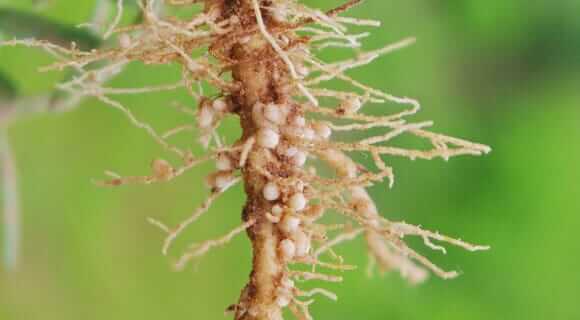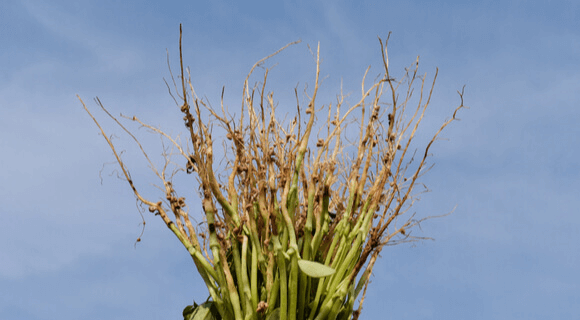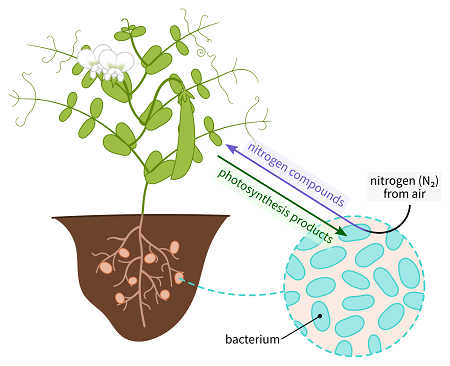Nitrogen Fixing BacteriaNitrogen, along with potassium and phosphorus, is one of the top essential nutrients for crop development, as it is responsible for photosynthesis and chlorophyll concentration. Nitrogen fixation in the soil is vital for agriculture because, even though dry ambient air contains 78 percent nitrogen, plants cannot eat it immediately. Its availability in a digestible form is vital for crop health. Fertilization isn't the sole choice; biological nitrogen fixation is a more cost-effective, environmentally friendly, and even lucrative option. Nitrogen-fixing microbes and crops make this feasible. What Is Nitrogen Fixation and How Does It Work?It converts the nitrogen present in the atmosphere into a reactive form of nitrogen present in a plant cell. This process is called nitrogen fixation because, in this process, some bacteria fix the atmospheric nitrogen into ammonia. After fixation, nitrogen is stored in the plant cells, where it works as nourishment for plants providing them with essential nutrients. Nitrogen fixation helps plants to grow and flourish. Without nitrogen, the plant will undergo dwarfism and show stunted growth, which is a disadvantage to plant yield. 
Soil bacteria are responsible for approximately 90% of natural Nitrogen fixing on our planet. Lightning and UV radiation are abiotic natural inducers. Nitrogen can also be repaired industrially or using some instruments. Nitrogen-Fixing BacteriaCertain species of bacteria have the talent to convert atmospheric nitrogen into a usable form of nitrogen inside plant cells. These microorganisms are called nitrogen-fixing organisms/ bacteria. They convert atmospheric nitrogen, N2, into ammonia, which is the organic form of nitrogen (nh4). Ammonia is a usable form of nitrogen. Data from different studies have shown that nitrogen fixation occurs on a huge scale. These species fix more than 90 percent of atmospheric nitrogen. Therefore, they play a vital role in the nitrogen cycle. Bacteria are divided into two categories based on the nitrogen fixation process -
AnabaenaNostoc, azotobacter, Clostridium, etc., belong to the first category and fixes nitrogen in a free-living state. On the other hand, bacterial species like rhizobia show symbiotic association with plants to nitrogen. 
In the latter case, rhizobia are associated with legumes, Frankia with dicot plants, and azospirillium species associated with cereal grasses. The symbiotic nitrogen-fixing bacteria infiltrate the root hairs of host plants, multiplying and stimulating the creation of root nodules, plant cell enlargements, and bacteria in close proximity. The bacteria in the nodules convert free nitrogen to ammonia, which the host plant uses for growth. Seeds of legumes (e.g., alfalfa, beans, clovers, peas, soybeans) are frequently inoculated with commercial cultures of appropriate Rhizobium species to ensure sufficient nodule formation and optimal development especially in soils weak in the bacteria. What are the Functions of Nitrogen-Fixing Bacteria?Even while legumes play an important part in Nitrogen fixation, the task is too difficult for them to handle alone. In reality, the process of nitrogen fixation is aided by the symbiotic relationship between legumes and nitrogen-fixing bacteria. Nitrogen-fixing bacteria convert inorganic chemicals from gaseous nitrogen in the air. Rhizobium is known for colonizing legume roots. Their symbiosis isn't the only option, though: there are other free-living and related N-fixing microbes. Nitrogen fixation is a very important process in the life cycle of certain plant species. It helps provide nutrients and acts as a natural fertilizer for various crops. Microorganisms that fix nitrogen do what crops can't: they get assimilative nitrogen. Bacteria absorb it as a gas from the air and release it to the soil as ammonia. Plants can only ingest nitrogen from the soil in the form of nitrogenous inorganic compounds, which explains the need for nitrogen fixation. What Role Does Nitrogen-fixing Bacteria Play in Crop Growth?Explained that it is required for plants to obtain nourishment. Chlorophyll is required for photosynthesis, which converts solar energy into chemical energy. N-fixing bacteria give crops ready-to-use nitrogen in the form of chlorophyll molecules, which they require. They also require N in the form of amino acids to build proteins involved in metabolism and energy storage. Food deficit occurs from a lack of N fixation, which causes plants' yellowing, thinning, withering, general growth delay, and decay. What Effects Do Nitrogen Fixing Bacteria Have on Soil Fertility?They increase soil fertility organically, allowing farmers to avoid using synthetic fertilizers. Inorganic Nitrogen-containing molecules, important crop nutrients, are saturated in the soil by nitrogen-fixing bacteria. Upon the death of bacteria that fixes nitrogen, all the nitrogen stored in their body is released into the soil, and it accumulates later into the plant from the soil. What Role Does Nitrogen Fixing Bacteria Play in the Nitrogen Cycle?By collecting nitrogen from the air and adapting for plant demands, N-fixing bacteria help to circulate nitrogen across ecosystems (fixation of nitrogen). Crops then utilize it to grow (N-assimilation). Decomposers divide nitrogenous molecules and release ammonia or ammonium when plants and microorganisms die (ammonification). Nitrifying bacteria convert ammonia to nitrates, either eaten by plants or decomposed by denitrifying bacteria. During denitrification, denitrifying bacteria convert nitrates into the free form of nitrogen that is N2 which is then released into the atmosphere once again. 
Although we have seen that nitrogen is very important for plants' growth but too much nitrogen can be very toxic to plants. Bacteria That Fix Nitrogen (N-fixing Bacteria) By Type of Plant InteractionThey have been categorized into different kinds based on how bacteria interact with plants. The two main categories are endophytes, which live inside plants, and exophytes, which live on the plants. There are symbiotic, associative, and free-living nitrogen-fixing microorganisms. However, it does not imply that the same kind is symbiotic or free-living. As a result, rhizobacteria can live on/inside plants and in the rhizosphere. Nitrogen Fixation in Symbiotic RelationshipsSymbiotic N-fixing bacteria produce nodules on the roots of their hosts, collecting atmospheric N2 and converting it to ammonia. The host uses it for growth, and as it dies, it is released into the soil via broken nodules. On the other hand, N fixation symbionts aren't doing the 'favor' for no reason. The bacteria feed on plant-produced carbohydrates (sugars) and absorb carbon since any symbiosis implies a win-win arrangement. Even while their N fixation symbiosis is legally described as infection, both sides gain greatly from it. As a result, mutualism is used to describe such a partnership. Rhizobium and Frankia are two common symbiotic N-fixing bacteria. Rhizobium, A Nitrogen-Fixing BacteriaA common example of nitrogen fixation is the connection between legumes and the nitrogen-fixing bacterium Rhizobium. Furthermore, it isn't the only benefit. Apart from acting as a source of fertilizers, nitrogen-fixing bacteria impart other traits to the plants. Some of their tolerance to diseases, pests, abiotic stress, and other environmental stresses. It also helps in gaining other nutrients from the environment. Therefore it forms a mutual interaction with the plants called a symbiotic association or relationship. 
N-fixing Rhizobium is normally found in association with other bacteria. Even if they are isolated by manufacturing nitrogenase and growing only on N2 from the air, they can participate in N fixing. If they can't locate a suitable host, they may become free-living. Frankia, A Symbiotic Nitrogen-Fixing BacteriaFrankia, like Rhizobium, fixes atmospheric nitrogen by root nodulation. Certain strains of it can also exist freely. The hosts of the two N-fixing bacteria species vary. Frankiacolonizesactinorhizal plants such as alder, bayberry, sweet fern, Avens, and others, allowing them to thrive in barren soil. Plant performance and soil conditions increase due to the N fixation symbiosis. In agroforestry, this nitrogen-fixing genus is commonly employed. Associative Nitrogen Fixation is a nitrogen fixation that occurs when two or more cereals and free-living N-fixing bacteria that may cling to the host roots form an associative symbiosis. Azospirillum, Glucenobacter, Acetobacter, Herbaspirillum, and Azoarcus are examples of this. Wheat, rice, corn, sugarcane, barley, sorghum, Setaria, biofuel crops like Pennisetum, and others are linked. Grains, unlike legumes, do not fix nitrogen in nodules; instead, they rely on nutrient availability in the soil, i.e., fixation. Bacteria, for their part, use air nitrogen for their requirements and share it with the host crop. Most N-fixing bacteria live on roots, although some, such as Herbaspirillum, are vigorous enough to infiltrate the entire plant. These microorganisms have the potential to improve crop development and yields, which is especially essential in poor soils. Nitrogen Fixation by Free-Living OrganismsCrops can also get nitrogen from free-living N-fixing bacteria. Rice farmers, for example, use aquatic Azolla ferns as green manure, and Azolla provides a home for Anabaena Azolla (a cyanobacteria variety known for its nitrogen-fixing abilities). Cyanobacteria may dwell in wet soils and inland aquatic bodies, either symbiotically or freely. This species combines unusual characteristics: it is categorized as bacteria, although it looks like algae. Cyanobacteria are phototrophs because they contain chlorophyll (like plants). They can, however, fix N2, unlike plants. Biological Nitrogen Fixation's AdvantagesSynthetic fertilization is largely used in intensive agriculture for N fixation, thus, damaging the environment. On the other hand, biological N fixation has proven to be beneficial to both farmers and the environment. It contributes to organic farming by efficiently implementing N-fixing crop species and maintaining a specified microbial balance. As a result, a low-maintenance nitrogen-fixing cover crop provides a considerable supply of Nitrogen in and of itself and the other benefits described above. N-fixing bacteria inoculants are an effective option for non-legumes. They enable farmers to do tasks without the need for artificial means. Furthermore, the efficiency of microorganisms extends well beyond N fixation since they enhance soil conditions, particularly when it comes to heavy metals. Maintaining an ideal N fixation balance with careful monitoring is key to success. EOS Crop Monitoring is a dependable online partner for farmers, available to monitor the situation 24 hours a day, 7 days a week. Rhizobium: Nitrogen-Fixing BacteriaRhizobia are several types of bacteria capable of 'fixing' nitrogen, that is, turning nitrogen gas into ammonia, which may later be converted into organic compounds like amino acids. Due to this capacity, nitrogen-fixing bacteria serve as important conduits between an enormous pool of nitrogen in the atmosphere and living creatures that would otherwise have to recycle nitrogen from existing organic nitrogen pools (e.g., amino acids, ammonia, nitrate, and nitrite). 
Rhizobia can only fix nitrogen when it is linked with a plant that feeds it with carbohydrates, unlike many nitrogen-fixing bacteria that can fix nitrogen when they are 'free-living' (when they are not living inside a host plant). Carbohydrates give energy for a process that necessitates large amounts of it (both ATP and the reducing power of NADH). Rhizobia are exclusively found in legumes, which are members of the pea family. (However, not all legumes connect with Rhizobia, and some that do may have bacteria other than Rhizobia as nitrogen-fixing partners.) Taxonomy and PhylogenyRhizobia belong to the Bacteria Domain. They are generally flagellated and motile gram-negative bacteria. As the capacity to fix nitrogen, the ability to associate with legumes is not phylogenetically relevant. As indicated by its existence in Archaea, Cyanobacteria (see Nostoc), and numerous other phylogenetically unrelated bacterial taxa, the ability to fix nitrogen appears to have developed separately several times (i.e., convergent evolution). Similarly, the capacity to interact with legumes (which may be considered a kind of parasitism) is assumed to have been passed down horizontally and hence isn't a useful phylogenetic signal (which reflects vertical gene transfer). As a result, the Rhizobia genus is classified as paraphyletic. StructureRhizobia are rod-shaped bacteria with a flagella diameter of 0.8 um and a length of 2 um. They take on a distinct form when they're within their host, becoming irregularly shaped and frequently 'Y'-shaped. Infection threads are formed within root hair cells due to their existence. Root hairs coil when they detect Rhizobia, and bacteria become trapped in the crook of the curl. The root cell wall is destroyed at this time, and bacteria grow beyond the root hair cell membrane. The root hair produces a tubular infection thread, which extends down into the root itself. The thread is made out of cell wall components and is essentially an elongated invagination of the cell wall, with materials from both the plant and bacteria. Next to the root cortex, the infection thread finally merges with the cell membrane at its base. The infection thread then infiltrates (infects) cortical cells, where the bacteria multiply. The cortical cells have de-differentiated and become meristematic as the thread progresses, resulting in the tumor (nodule) characteristic of Rhizobium infection of roots. Matter And EnergyRhizobia are heterotrophs that may associate with photosynthetic plants and receive carbohydrates ('food') and any nutrients (i.e., mineral elements) they require, except nitrogen, which they obtain from the air, which is abundant. The element molybdenum is very crucial in the nitrogen fixation process. When Rhizobia live outside of a plant, they are heterotrophs that feed on dead organic matter and use the material obtained as both 'building material' for growth and substrates for cellular respiration to provide energy. InteractionsRhizobium and its host plant must communicate (signal) for them to be able to connect with legumes. Both the plant and the bacterium release factors that influence the other's gene expression and activity. 
The gallbladder cells create leghemoglobin, a kind of hemoglobin that may bind oxygen and limit the quantities of free oxygen, which is poisonous to the nitrogen fixation process. The nodules establish vascular connections, which allows them to be 'fed' carbohydrates supplied by the host plant. These are largely utilized to fuel the nitrogen fixation process' high energy needs, but they also offer carbohydrate molecules to which the fixed nitrogen is bound. The bacteria take in N2 and emit ammonia, which the host plant converts into organic acids, amino acids, or other nitrogen-containing molecules. Rhizobia can be completely parasitic, meaning they feed on the plant but don't produce any fixed nitrogen.
Next TopicBacteria in Curd
|
 For Videos Join Our Youtube Channel: Join Now
For Videos Join Our Youtube Channel: Join Now
Feedback
- Send your Feedback to [email protected]
Help Others, Please Share










